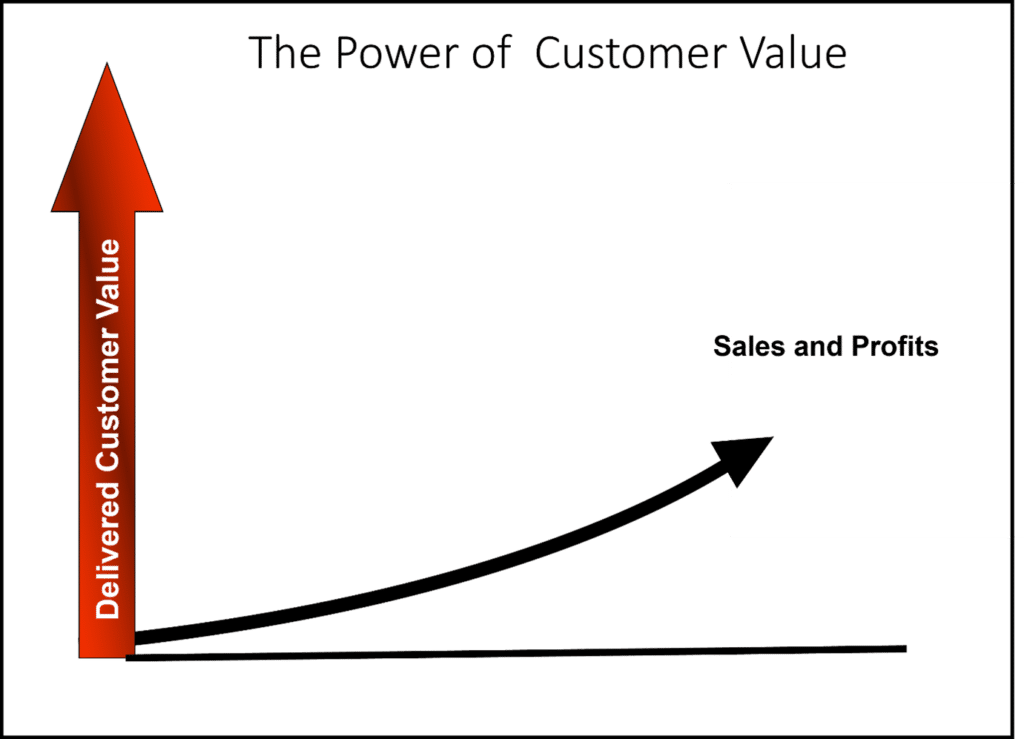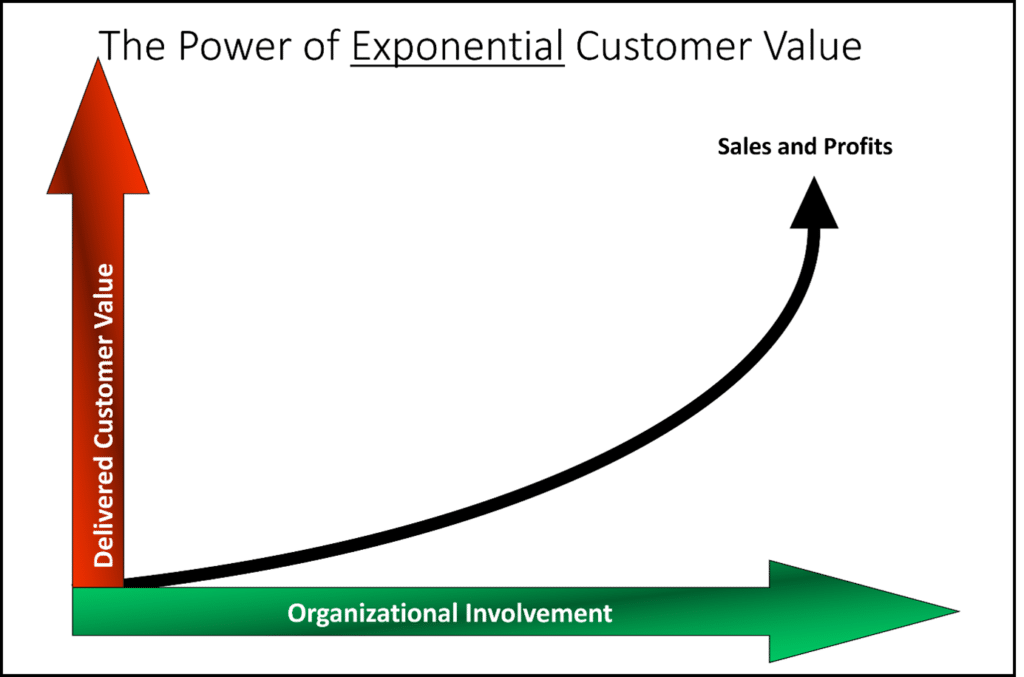David Packard, co-founder of Hewlett-Packard, famously said marketing is too important to leave to the marketing guys. He was absolutely right. Creating and delivering exponential customer value, the core function of marketing should be everyone’s job in your company. But I’ll go one step further and say strategy is too important to be left solely to the company’s leadership.
To optimize the effectiveness not only of your marketing but of how you operate your entire business, you need to shift your attitudes and beliefs about strategy to include the people who are getting the job done every day in your organization – from the domain of a few to the involvement of all. A limiting factor in many companies is that they think about strategy in such lofty terms that it has become detached from what is really going on in the business on a daily basis.
Strategy only sounds like a big word. It is about finding the best way to accomplish something so you get somewhere. It is the means by which you accomplish a goal or objective. A good strategy is a more effective and efficient way of achieving an objective than a bad strategy. It’s pretty basic stuff. So, why make it complex and exclude so many in the organization from thinking about how best to accomplish their particular objectives? The people who are probably best at figuring out a more effective and efficient way to get things done are the people who are doing the job or task where it is happening, as it is happening.
Everyone in your organization can and should think strategically about what it is that they do. And to do that, you as a manager, need to start by stripping all the lofty trappings from the word ‘strategy’ and get to what strategy really means at its core – finding the most effective and efficient means of accomplishing an objective. Tactics are the details of actually getting it done. To be effective, people – regardless of the level or function in your organization – need to be adept at both: strategies and tactics.
This is where exponential comes into play. Finding a killer strategy is not just about deciding the best course to get to a better place. It is also about powering up the organization so that growth-generating ideas aren’t being pursued only from above. Instead, everybody is thinking about how to get there faster and smarter. Strategy shouldn’t be ‘owned’ on the basis of the corporate hierarchy. It shouldn’t be something that is simply passed down from above. Strategy should become a way of thinking that is embraced and practiced at all levels in your organization.
Unfortunately, ‘strategic’ is one of the most judgmental words used in business. Too often it is used to describe a person’s depth of thinking. ‘Linda is a strategic thinker; John is more of a tactician.’ Who do you think is going to be picked for promotion?
The first truth is that the difference between a strategy and a tactic is often merely a question of how you draw your circles. One person’s strategy might simply be another person’s tactic.
The second truth is that everyone has both a spatial and a linear side to their brain. We all come from the factory hardwired with the capability to think both tactically and strategically. Don’t make the mistake of using the word strategy as an attempt to separate the thinkers from the doers in your organization. I’d prefer to have doers who think in my company. Wouldn’t you? Anyone can become strategic if they are allowed to participate in how they do their job. You can approach a task strategically, or tactically. It’s best that you do both, one after the other.
The key to unlocking the strategic capability in your organization is to assign objectives rather than merely tasks. Give someone an objective and ask that they come back to you with their strategy on how best to get it done. The details are the tactics they intend to use to achieve that objective. Imagine the exponential power of that creative and innovative thinking!
Everyone up and down the organization needs to think strategically, not only in terms of how they align the execution of their objective with the strategy from above, but also in terms of how they can power up the execution to have a greater impact on providing customer value.
We know that if we deliver greater customer value our business will grow. As my boss at Coca-Cola, Sergio Zeeman, used to pound into my head: Marketing’s purpose is to sell more stuff to more people, more often, and for more money.

It’s pretty clear that marketing – creating, communicating, and delivering customer value – goes far beyond producing great commercials and integrated brand communications. It lives and breathes with everything your organization does that impacts the quality of your products and/or service. So why aren’t you embedding that understanding and execution of customer value throughout your business so that everyone is thinking about what you do for customers and how they as an individual or group of individuals inside the company make customer value happen? Why don’t you give them the freedom and encouragement to create, communicate, and deliver customer value better and better as they all continue to evolve and grow in their jobs and functions?

Trust the strategic thinking power of the people you work with. Try implementing this exponential value approach. It will lead to exponential strategy in places and activities happening throughout your organization that you never thought of before. If you open up the strategic playing field to find these hidden ways to do things differently, better, your business will grow. Exponentially. You will be amazed by how much customer value power can be generated if you encourage people across your organization to think strategically about how they execute their tasks and functions.
It’s relatively simple to do. Only two steps are required to unleash the exponential power of strategic thinking throughout your organization.
- Make sure that everyone understands the meaning of customer value and how it applies to them. This ensures that instead of just doing things, they do the right things – the things that will positively impact the customer experience and add customer value.
- Assign objectives rather than tasks. Ask people to think about their objectives and come back to you with ideas (i.e., strategies) about how they can build or deliver greater customer value to accomplish each particular objective.
To get people to participate enthusiastically in strategy in your organization, recognize and appreciate their individual contributions.
Exponential leadership
Think more about ‘leading’ and less about ‘managing.’
Many managers pride themselves on their ability to keep their arms around a lot of difficult activities at the same time. They often feel irresistibly drawn to personally solve even small problems as they come up. They also tend to stay very busy. Overly busy managers make me nervous. I wonder when they find the time to think.
Leaders find a way to rise above all of that. They understand that having time to think, and the insights and ideas gained from that thinking, are invaluable. The most important managerial skill required for today’s leaders in super-complicated and highly competitive environments is the ability to separate the must-dos from the can-dos and should dos. I’ll take intense focus over incredible energy any day. Busy and effective do not automatically go hand in hand.
Exponential leaders go even further than mere focus. They have discovered the power of spreading and inspiring leadership throughout the organization. Leaders have developed both the business understanding to figure out where to go and the human understanding to get everyone involved in the process of getting there. And as a result, they get there faster – exponentially faster. These exponential leaders know that the secret of getting people’s emotional commitment is to understand what motivates them as human beings. They have the flexibility to adjust assignments to incorporate their employees’ personal and professional goals – both matter.
Think less about control, and more about influencing. ‘Command and control’ managers believe they are avoiding problems and ‘saving’ the company by controlling activities so tightly that nothing can go wrong. At best, they achieve an error-free company. But what about finding new ways to do things that take customer value even higher? ‘Lead and influence’ managers grow value by encouraging others to do better.
Exponential leaders inspire leadership in others. They don’t just personally light a fire in an organization; they create an atmosphere and an environment where thousands of fires are lit – every day.
The exponential value chain
You know that you need to meaningfully involve customers to achieve customer value, and you know you need to involve your employees to do that. But think outside your company as well.
In most businesses there are a lot of contacts and factors that affect customers that you can’t possibly control, but you definitely should do your best to try and positively influence them. They affect customer value – that’s why they call it the ‘value chain.’ These are the suppliers upstream; the distributors, the wholesalers, the retailers, and the dealerships downstream; right down to the customer. You must market through the value chain. The power of customer value grows exponentially as it goes through the chain when you ensure that everyone from distributors to front-line sales people, not only understand the motivational architecture of your brand and its related benefits, but they also enthusiastically embrace it. The tenet – involve them so that they will understand – applies to salespeople, distributor reps, and retailers, just as it does to end-user customers and consumers.
Marketing understands the target’s needs and then meets those needs in a meaningful, deliverable, defendable way. Market to the customer. Market to the sales force. Market to the distributors. Market to the retailers. Just as you will enjoy customer loyalty when you market-relevant benefits (functional and emotional) to customers in a meaningful, deliverable, defendable way, so, too, will you enjoy success when you market through the value chain with the same sort of value-added thinking.
I often hear marketers complain that the sales guys think they are marketing experts. They are! And more than those marketers realize! A sustainable advantage you can have as a marketer is to treat the rest of the organization – especially the sales force – as marketers. Be inclusive. Involve them in the marketing. Share the customer data with them. Seek their counsel. Not only will the sales guys understand what it is you are trying to achieve with the brand, but they will also become enthusiastic proponents of the brand strategy and all the unique ways they can power your brand’s benefits to the end customer. They also know a lot about the customer and the rest of the value chain so the communication should absolutely go both ways.
Do the math. If you work very hard as a good marketing manager, you can communicate effectively with a maximum of maybe 100 salespeople to ensure that they understand and embrace the brand’s value. Now imagine that those 100 sales guys go out and call on 1000 distributor reps with all the necessary tools to make sure they understand and embrace the brand’s value. The distributors and their salespeople are then armed and ready so that they can involve 25,000 retailers. Those retailers can now understand and enthusiastically embrace the brand, and they have tools and information they need to sell 10,000,000 customers. Get the picture? Performance alignment is spending a lot more time than you probably have up until now on marketing to the value chain.
I had a policy at Coca-Cola that each individual in the organization had to be able to participate in every marketing program before it was shown to customers. That wasn’t easy to do because we had over 1300 people performing a lot of different activities around the clock throughout the country. Members of the marketing staff at Coca-Cola, including myself, would often travel out to the various sales centers to discuss what we were planning on doing in the days and weeks ahead. And, of course, we included production – even in the middle of the night with the graveyard shift (23:00–7:00). Not only did we get some good ideas from holding these input sessions, we also ensured that everyone understood what we were doing and why we were doing it. This knowledge empowered them to incorporate their understanding into how they perform their own job, whatever it was. And with their input, they helped us do our job better and more efficiently. We also created a thousand points of communication to end-user consumers. Think about it. The guy on the filling line who is watching the glass bottles go by and making sure everything is okay may also be the head of a rather extended family. Imagine one Sunday at his family dinner when someone remarks that they have heard about a new activity Coca-Cola is running. In most companies, he would have to shrug and admit he doesn’t know anything about it. We took a different approach and armed him with enough information so that he would not only feel good about where he worked and why he worked there, but he could also spread by word of mouth why it is important and significant to Coca-Cola customers. Getting up in front of a hundred production workers in the middle of the night before they start their shift isn’t just a good HR idea, it’s good business. It’s good marketing.



